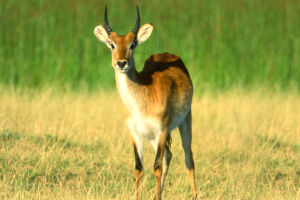Greetings to Lykkers! The Great Crested Grebe (Podiceps cristatus) is a fascinating waterbird, easily recognized by its striking plumage and elegant movements.
Found across a variety of freshwater habitats, this species captivates both bird watchers and nature enthusiasts.
Great crested grebes courtship dance | WWT
Video by WWT
In this article, we will explore the features, habitat, behavior, and conservation status of the Great Crested Grebe, offering a deeper insight into one of nature’s most graceful creatures.
Physical Characteristics of the Great Crested Grebe
The Great Crested Grebe is known for its striking appearance. During the breeding season, both males and females sport a dramatic headcrest of black feathers that gives them a regal, almost majestic look. Their plumage is mostly white with black markings on their head and neck. The contrast between their black and white feathers, especially in the summer, is striking and makes them stand out on the water.
The long, slender body of the grebe allows it to glide effortlessly through lakes and ponds. Its sharp, pointed bill is perfectly adapted for catching fish, which forms a significant part of its diet. The bird’s bright red eyes add to its intriguing and mysterious look, making it a truly unique sight to behold.
Habitat and Distribution
The Great Crested Grebe can be found across a wide range of regions, from Europe to parts of Asia and Africa. It thrives in freshwater lakes, ponds, and wetlands, particularly those with abundant vegetation and clear waters. These areas provide the perfect environment for the grebe to hunt for fish, its primary food source.
The bird is migratory in some regions, particularly in northern parts of Europe, where it migrates to warmer climates during the winter months. The Great Crested Grebe’s adaptability to different water bodies and environments has allowed it to become widespread, though it still relies on clean and undisturbed water sources to maintain its population.
Behavior and Diet
The Great Crested Grebe is an excellent swimmer and diver. It hunts primarily by diving underwater to catch small fish and invertebrates. Known for its graceful, almost ballet-like movements, the grebe can swim for long distances in search of food. Its diet mainly consists of small fish, such as perch, and aquatic invertebrates, which provide the necessary nutrients for its survival.
During the breeding season, the grebe exhibits fascinating courtship behaviors, often involving synchronized movements with its mate. The two birds will engage in mutual displays, which may include diving together and presenting each other with fish as a sign of affection. This cooperative behavior plays an essential role in strengthening their bond and ensuring a successful breeding season.
Breeding and Nesting
The Great Crested Grebe is known for its elaborate courtship and nesting rituals. These birds typically build their nests in dense vegetation along the water’s edge, where they can remain hidden from predators. Both parents share the responsibility of building the nest, which is usually constructed from aquatic plants and reeds.
Once the nest is built, the female lays a small number of eggs, usually between two and five. Both parents take turns incubating the eggs until they hatch, which typically takes around 3-4 weeks. After hatching, the chicks are born with the ability to swim and dive, and the parents continue to care for and protect them until they are ready to fend for themselves.
Conservation Status
The Great Crested Grebe is currently classified as a species of “Least Concern” by the International Union for Conservation of Nature (IUCN). This means that the species is not at immediate risk of extinction. However, like many waterbirds, it is still vulnerable to threats such as habitat destruction, pollution, and climate change. Conservation efforts aimed at preserving freshwater habitats are essential to ensuring the survival of the Great Crested Grebe.
Conclusion: The Beauty of the Great Crested Grebe
In conclusion, the Great Crested Grebe is a remarkable bird that showcases the beauty and elegance of the natural world. From its striking plumage to its graceful movements on the water, this species continues to captivate all who are fortunate enough to observe it. While the grebe is not currently endangered, ongoing conservation efforts are crucial to maintaining the delicate balance of freshwater ecosystems and ensuring that future generations can enjoy the beauty of these magnificent birds.
Thank you for reading, and we hope you continue to explore the wonders of nature. Lykkers, keep appreciating the beauty around us, and let’s work together to protect these fascinating creatures.


